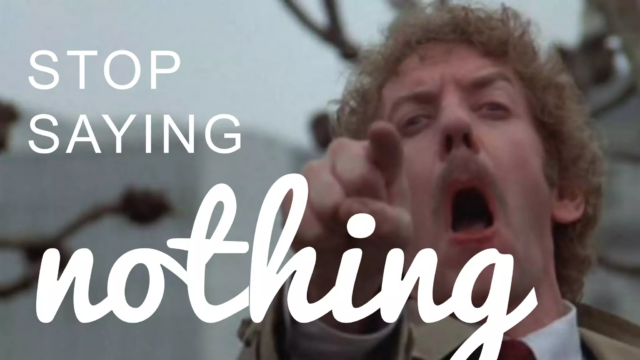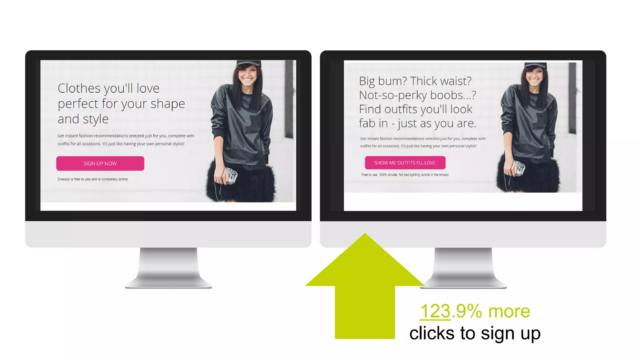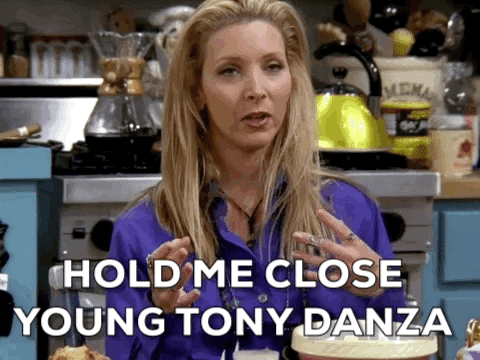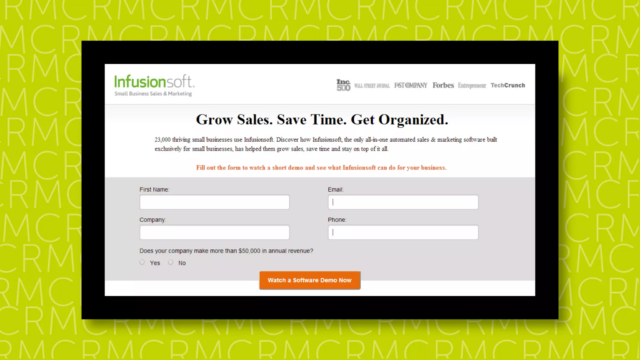Software, to the average person, is pretty boring.
‘Words are actually free. Now, getting them wrong is expensive. But if we can get them right and get some attention on our copy, we can actually stand out – even if we’re no different from our competitors – because everybody saying the same meaningless things,’ Joanna Wiebe, founder of Copyhackers says in her 2015 BoS USA talk.
Read on to learn why your words aren’t getting through and how to write copy that converts.

For a full version of this talk, including a video recording and transcript, click here.
Table of Contents
‘Stop Saying Nothing’: What It Means
Why Your Current Copy Isn’t Working
Your predictable copy is boring.
You’re afraid to get creative.
You’re trying to ‘make it sing.’
Polished copy isn’t noticeable.
How to Write Copy for Your Software Company
1. Audit your competitors’ website copy and content.
2. Search Amazon for customer reviews on industry-related products or books.
At the end of the day, we all want to be entertained.
‘Stop Saying Nothing’: What It Means
Wiebe argues that much of the copy on software lacks a certain pizzazz: It’s full of business and industry-related jargon, is less-than-memorable, and often falls woefully short of what it’s intended for.
‘The less exciting your product is, the better your copy needs to be,’ Wiebe asserts. What she really means is that your copy needs a dash of personality – a major reason why her original talk was titled, ‘Oops! Your Personality Is Showing.’
Creative and compelling copy is what makes your website not only visible (and we’re not talking about being actually seen with eyes but ‘seen’ in a way that garners attention) but also entices your visitors to take action.
‘You should be strongly considering using more personality in your copy,’ Wiebe says. To make her point, she briefly describes findings from a few academic studies suggesting that personalised characteristics matter in copy and content.
One study tested how bottled water brands can use personality in their branding to improve consumer brand recognition and preference.
Find out more about BoS
Get details about our next conference, subscribe to our newsletter, and watch more of the great BoS Talks you hear so much about.
‘When [the researchers] took a neutral normal bottle of water and measured it against 5 other bottles of water that were assigned human personality traits, they found people were more likely to buy the brands that had some sort of personality they could call human and that they were three times more likely to recall it.
‘Now, if we’re trying to stay in people’s heads long after, especially if we want them to talk about us and share us, we can’t be neutral. You can’t afford to be neutral, especially if your product isn’t that different from the next guy’s,’ she explains.
Adding personality to your website copy and content is what grabs customers’ attention, piques their interest, and drives them to take action and buy from you. Predictability and polish are a smokescreen: If you’re writing professional-sounding copy but forget to add some authenticity, you have little hope of standing out or being memorable.
Why Your Current Copy Isn’t Working
Figuring out why your copy isn’t converting takes a bit of trial and error. There’s more than one way it could be failing. The only way to get it right is by doing an audit of your own site and getting honest with your words.
Is it boring?
Does it lack creativity?
Is it so creative that it’s unclear?
Is it too polished?
Read on for Wiebe’s breakdown of each and how you can self-diagnose your own copy shortcomings.
Your predictable copy is boring.
Predictability bores brains. And just as James Clear teaches in his best-selling book, Atomic Habits, we form habits to give our brains a break. ‘The brain is continually scanning the environment, predicting what will happen next, trying out different responses, and learning from the results. The entire process is completed in a split second, and we use it again and again without realizing everything that has been packed into the previous moment,’ Clear writes.
In essence, we get into a groove, and our brains learn to recognize patterns. To conserve energy, we ignore most things that appear somewhat predictable. In fact, it takes a lot to make us stop and take notice.
So, how do you stop your website visitors in their tracks?
‘Say what your competitors won’t’, Wiebe says. ‘Different is the only thing that stands out.’
Using words your customers are using will get their attention more than using generic or common industry-related words. This can be a lot more successful than you (or your company’s C-level executives) might think.
To demonstrate this power of (un)predictability, Wiebe shared an example of when she and her team wrote test copy for a fashion website landing page. Some customers got the typical “find clothes that fit your body”-kind of page; others got a page covered in copy that used phrases and words taken from customer reviews on purchases.
The results were both shocking and undeniable: The “test” copy resulted in nearly a 124% increase in clicks to sign up for the company’s emails.

You’re afraid to get creative.
There’s a reason Shakespeare’s classics have endured for more than 400 years. The man (or woman, depending on who you ask) was a genius when it came to using creative words to, as Wiebe says, to ‘trap’ people.
‘We can use our words to “trap” people, as bad as that sounds, and to get them to pay attention to us,’ she says. ‘Shakespeare made an entire, huge, amazing career out of getting people’s attention – out of getting them to notice what he was saying. He was a master of words and a master of using unexpected words, too.’
Talk about being noticeable: Shakespeare created or changed the use of literally hundreds of words. His use of language is what drew so many to his plays and why we still revere them today.
Now, all of this is not to say you should go coining your own new words or try making ‘fetch’ happen à la Gretchen Wieners in the original Mean Girls movie. But what Wiebe does recommend is injecting some Shakespearian creativity into your copy. She goes on to explain, ‘He was trying to get your attention, and he used words that would do that… These [were] unexpected; these [were] noticeable words that are not invisible, and they’re not trying to fade into the background.’
You’re trying to ‘make it sing.’
Wiebe argues that this might be some of the worst writing advice of all time.
We’ve all misheard the lyrics to a song. Who could forget Phoebe Buffay’s rendition of Elton John’s “Tiny Dancer” or comedian Peter Kay’s review of songs he’d been hearing wrong for years?

Polished copy isn’t noticeable.
Polished words aren’t what Wiebe calls ‘sticky’ – they aren’t memorable and don’t spur readers to take any action. And despite people sometimes not knowing what it is they’re looking for, polished copy is definitely not it.
Wiebe uses a screen grab from an Infusionsoft (now called Keap) landing page.

‘I have no idea why I should care about that. And will any of that actually stick with me? Did any of that stick with you? Did you walk away saying, “Infusion soft, those are the guys who help me gross sales, save time and get organised?” Of course not, right? You might later, but let’s be honest with ourselves: Polish isn’t what people are looking for,’ Wiebe insists.
This kind of ‘polished copy,’ Wiebe goes on to argue, is exactly the kind of thing we, as consumers, have learnt to ignore.
‘We want to avoid the things that are very familiar and very comfortable: Sort of phrasing “the future of ‘blank’ is here – please don’t! And “welcome to the new ‘blank.’” These kinds of things are patterns – they’re predictable. Nobody even notices the last word; it could be anything, and anybody can say any of that,’ she explains.
Instead, Wiebe says you should try to incorporate what she calls ‘jagged edges’ into your copy. These jagged edges are what make copy stick to your website visitors and readers.
‘Try using words that are like a thorn bush – words that are there to cling to you, to catch you. To make you uncomfortable. To make you notice them – not to confuse you, catching you by being strangely confusing so you can’t make sense of it, but words that you didn’t expect to see. It’s the unexpected that we notice. It’s the unexpected that sticks with you a little while longer.’
You’re making excuses.
Creativity often gets left by the wayside when it comes to things like Search Engine Optimisation, Conversion Rate Optimisation, or writing copy for B2B sites.
Wiebe preaches that this is not only a mistake, it’s a crutch.
‘There’s a sense that B2B copywriting is [boring], right? And it’s completely untrue. I think that we all want to be entertained.’
Boring, predictable, polished, search engine-optimised copy doesn’t convert at the same rates that creative, entertaining, ‘sticky’ does. Sometimes, it’s okay to skip the SEO.
How to Write Copy for Your Software Company
Writing creative, attention-grabbing copy for your software company website isn’t as much of a challenge as you might think – even if you’re not a copywriter. The key is to know where to look for inspiration and how to write in a way that will reach your audience and wake them out of their scrolling slumber.
At Copyhackers, Wiebe teaches her students to do 3 consistent things.
1. Audit your competitors’ website copy and content.
You can learn a lot from how your competitors are saying things on their websites. And if you have multiple competitors, you can learn even more by comparing and contrasting them against each other.
When Wiebe gave this talk, many of the web traffic tools that exist today were still being developed. Now, you can compare approximate website traffic numbers from websites and pages other than those you own. This will give you some great insight into what kind of copy might be performing better.
‘A key question we should always be asking is, “Is that how [my prospects] talk?”’ Wiebe says.
Wiebe’s point is crucial. Remember the fashion website example above that used specific words from customers’ reviews? The one that reflected the same words used over and over by customers is the one that performed better.
By using the same words and phrases your customers use, you’ll be more likely to get their attention and entice them to take action. If your competitors are (or aren’t) doing this, take note! Emulate (but don’t copy or plagiarise) what they do well and steer clear of things that look too jargon-heavy.
2. Search Amazon for customer reviews on industry-related products or books.
Amazon reviews are not only hilarious, but they’re also a great place to mine for copy ideas. Because Amazon is the place to buy ‘all the things,’ it makes it an ideal hub for getting solid, humanised feedback from people who are probably like your ideal clients.
Look for the kind of comments and feedback that suggests how your audience wants to be spoken to. Look for memorable words or phrases that crop up repeatedly. And most importantly, take note of what the reviewers are looking for: What are their pain points, and what do they want?
If you’re struggling to find the right tone, try mapping them using Jennifer Aacker’s Brand Personality Scale. According to Aaker, there are 5 personality traits that brands can channel to humanise themselves and better connect with their prospects: Sincere, Competent, Excited, Sophisticated, and Rugged. Deciding what personality characteristic best aligns with the reviews you’re finding will help you decide how to approach your audience.
‘People like to do business with people who are like them,’ Wiebe reminds her listeners. ‘The more people see and hear themselves in your copy, the more they’re likely to like you.’
3. Write for ‘3 AM readers.’
Sometimes, our copywriting ‘risks’ aren’t actually very risky at all. Or maybe it’s just not risky enough to get the job done. This is why Wiebe swears by writing for what she calls ‘3 AM readers.’
‘Try writing for your prospect when it’s very early morning or late, late at night. Write to wake your prospect back up. That’s when you’re probably taking the right level of risk at least the level of risk worth testing,’ she explains.
Here are Wiebe’s suggestions on how to begin writing for a ‘3 AM reader.’
- Be clear. Even though you want to write with personality, you don’t want to be so clever you become unclear. Start by clearly defining your message.
- Use short words. Skip the thesaurus and stick to what people can quickly understand.
- Sprinkle in unexpected words. Channel your inner Shakespeare and use a few words that might gain more attention.
- Break familiar patterns. Avoid ‘text walls’ and write in shorter paragraphs that are easier to skim and scan. Use alliteration in headlines. Use phrases your customers use and write ‘sticky copy.’
- Use short sentences. Fragments, too. No one wants to read a dissertation on your website. Keep things short and to the point when possible.
- Skip the parts your prospect skips. If you can test where your customers are not directing their attention, cut it out. If you read your copy and glaze over a section, your customers may, too. If it’s not necessary to the overall message, run tests by removing those sections.
At the end of the day, we all want to be entertained.
‘You don’t get bonus points for being quiet. This isn’t the silent game,’ Wiebe says as she closes her talk. She goes on to connect Harry Potter with writing great copy – something unexpected indeed.
‘Harry Potter should be the punchline to everything, I think. But accountants read Harry Potter, professional lawyers, doctors, surgeons – they all went home when Harry Potter was coming out and looked forward to reading it to escaping with words that make us feel something differently.
If we’re so willing to do that in our free time, what makes us really think that people are going to be so against this when they’re at work? That they actually don’t want any language that’s going to pull them in? That they just want the facts? It’s not actually true, or we wouldn’t have this huge publishing industry with people who are desperately soaking up stories that are told using interesting words,’ she insists.
Follow Wiebe’s advice to write copy that will decrease bounce rates, increase clicks, and delight your audience. All it will take is doing your research, getting creative, and for the love of Romeo, shunning industry jargon like the plague.
Click here to watch Joanna Wiebe’s full talk and hear more examples from her experience building Copyhackers. You can also find her on X (Twitter) or connect with her on LinkedIn.